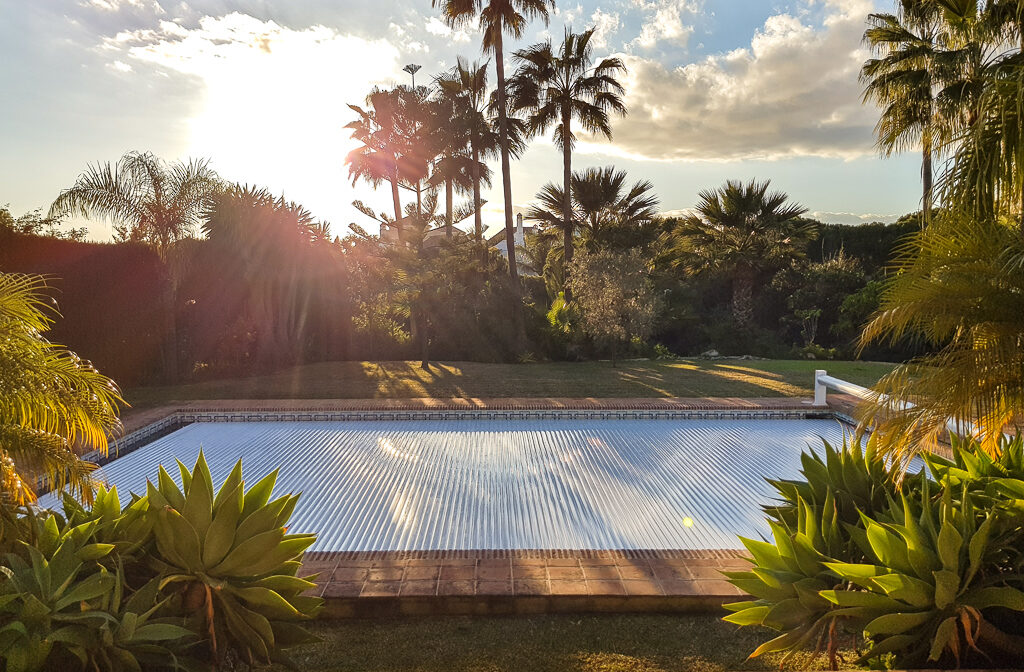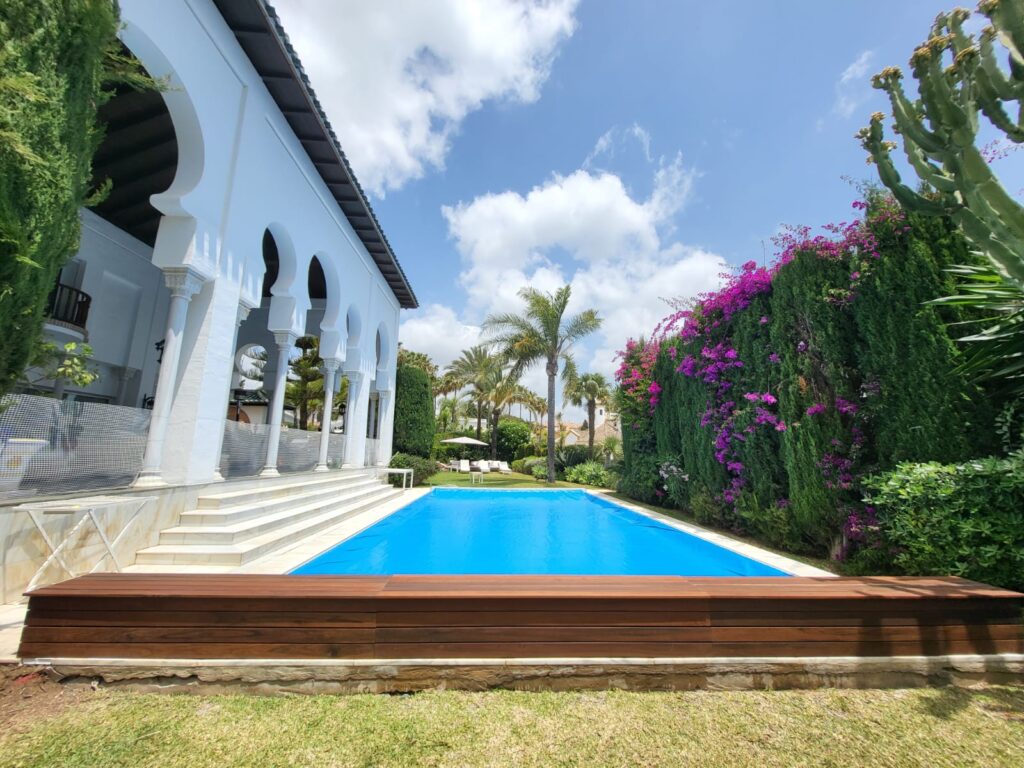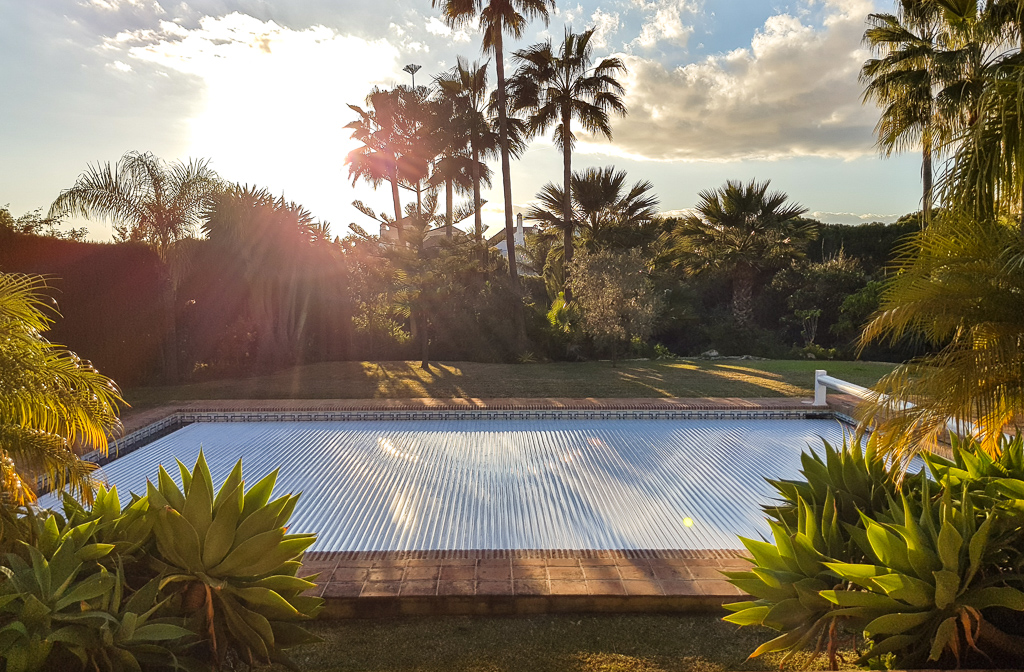Whether or not to install a cover on your pool is a big decision for a pool owner. The question of aesthetics is always important. In the end it boils down to what benefits you will get from the cover to offset the fact that the view of the pool will change, sometimes only minimally. We would like to offer our view based on three and a half decades of experience installing many types of pool covers.
The first question is, what will be the purpose of this cover for you? Pool covers can have several purposes like heat retention, safety for small children and pets, reducing evaporation, reducing chemical use and keeping your pool clean. We will now explain what types of covers offer which benefits. We should mention at this point that by law you should have some type of safety system on your pool, normally a fence or a cover. By installing a good safety cover you will avoid having to install an unsightly fence.
- Manual covers like the classic `bubble-wrap´ type are good heat retention covers and have the great advantage that you can roll the whole thing away in the summer months and store thus improving the aesthetics of the pool area. The main disadvantage of this type of cover is that they are not only not safety covers but they actually make your pool more dangerous should a small child or a pet fall on the side of the cover as they can easily end up underneath it. They can help a bit in reduction of evaporation and chemicals but don´t really help to keep your pool cleaner as most of what goes on the cover ends up in the pool. There is also a manual version of the vinyl CAP cover that we will mention further down in this post which scores top points in all these benefits.
- The most popular of the automatic covers is the slat type´. These covers are aesthetically pleasing and come in various formats. The slats can be made from PVC or Polycarbonate, the former being more appropiate for warmer climates as the polycarbonate slats can easily be damaged in the hot sun. Slats come in an array of colours from transparent to black, generally including white, grey, beige and blue. We don´t recommend the black as the water can get very hot underneath the slats and requires continuous water movement. If the pool circulation pump were to stop for any reason the slats can warp and be damaged beyond repair. The white slats look the same after many years in the sun, the other colours will fade, an important point to take into account before deciding on a colour. These covers are excellent heat retention covers and will make your pool totally safe as well as reducing evaporation and chemical use. As with the manual covers, most of what goes on the cover will end up in the pool so this cover doesn´t help much with keeping your pool cleaner. This type of cover comes in different formats. the above ground installations are available with a simple visible roller and with different types of benches the cover can roll in to. There are also submerged installations which can be in the bottom of the pool, just below the surface covered with duckboards or in a separate pit attached to one end of the pool. These submerged types need great care to be taken in the installation and maintenace as any error can cause very costly damage. The above ground models can even be solar powered for smaller pools.
- The PVC cover with tracks, known in Europe as CAP, is available in manual and automatic versions, and with several finishes, from a basic finish where you see the cover rolled up on its roller to tropical hardwood boxes that cover the roller and look very stylish. This cover scores top points in all departments. It´s an excellent heat retention and safety cover and will keep all leaves and debris out of the pool as well as eliminating evaporation and reducing chemical use.
- Pool enclosures are also relatively popular though they´re a totally different ball game as there is alo a need of a floating cover plus heating and dehumidification to avoid the discomfort of the condensation dripping off the ceiling on you.


As a summary of the pros and cons of these different types of covers we would say that the manual covers have the advantages of being more economical and removable when not needed but the disadvantage of being a deathtrap for small children, except the CAP type (see below). The slat type covers are generally considered to be the nicest looking of the covers available on the market and tick most boxes. They´re quite a big outlay compared to the manual covers but definitely a better mid to long term investment. The CAP covers, manual and automatic, are the best all-round covers except, arguably, regarding aesthetics and price, as they are the biggest initial investment.



